|
Microsoft Developing SQL Databases (70-762) Exam (Dumps)
Question No:-2
|
HOTSPOT -
Note: This question is part of a series of questions that use the same scenario. For your convenience, the scenario is repeated in each question. Each question presents a different goal and answer choices, but the text of the scenario is exactly the same in each question in this series.
You have a database named Sales that contains the following database tables: Customer, Order, and Products. The Products table and the Order table are shown in the following diagram.
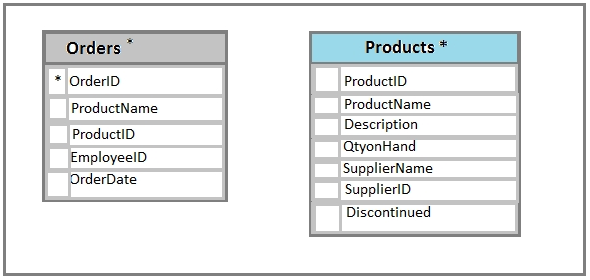
The customer table includes a column that stores the data for the last order that the customer placed.
You plan to create a table named Leads. The Leads table is expected to contain approximately 20,000 records. Storage requirements for the Leads table must be minimized.
You need to implement a stored procedure that deletes a discontinued product from the Products table. You identify the following requirements:
- If an open order includes a discontinued product, the records for the product must not be deleted.
- The stored procedure must return a custom error message if a product record cannot be deleted. The message must identify the OrderID for the open order.
What should you do? To answer, select the appropriate Transact-SQL segments in the answer area.
Hot Area:
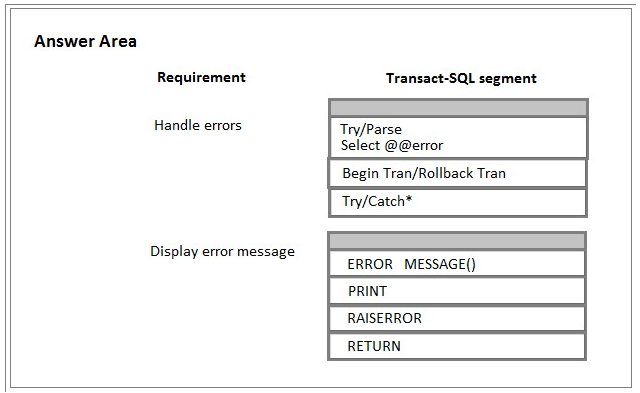
Answer:-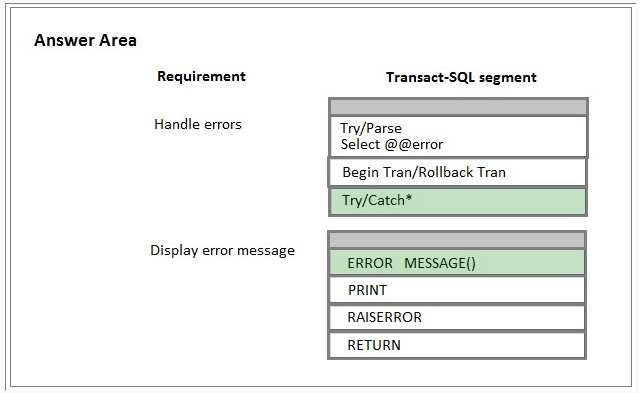 Note:-
Note:-
Using TRY...CATCH in Transact-SQL
Errors in Transact-SQL code can be processed by using a TRY"¦CATCH construct.
TRY"¦CATCH can use the following error function to capture error information:
ERROR_MESSAGE() returns the complete text of the error message. The text includes the values supplied for any substitutable parameters such as lengths, object names, or times.
Reference:-https://technet.microsoft.com/en-us/library/ms179296(v=sql.105).aspx
|
|
Question No:-3
|
HOTSPOT -
Note: This question is part of a series of questions that use the same scenario. For your convenience, the scenario is repeated in each question. Each question presents a different goal and answer choices, but the text of the scenario is exactly the same in each question in this series.
You have a database named Sales that contains the following database tables: Customer, Order, and Products. The Products table and the Order table are shown in the following diagram.
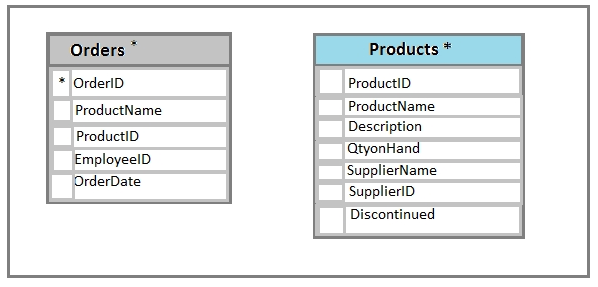
The customer table includes a column that stores the data for the last order that the customer placed.
You plan to create a table named Leads. The Leads table is expected to contain approximately 20,000 records. Storage requirements for the Leads table must be minimized.
You need to create triggers that meet the following requirements:
- Optimize the performance and data integrity of the tables.
- Provide a custom error if a user attempts to create an order for a customer that does not exist.
- In the Customers table, update the value for the last order placed.
- Complete all actions as part of the original transaction.
In the table below, identify the trigger types that meet the requirements.
NOTE: Make only selection in each column. Each correct selection is worth one point.
Hot Area:
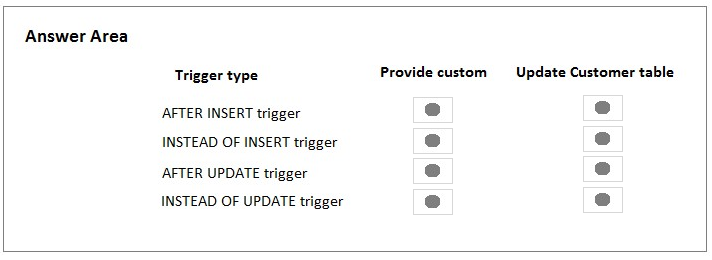
Answer:-
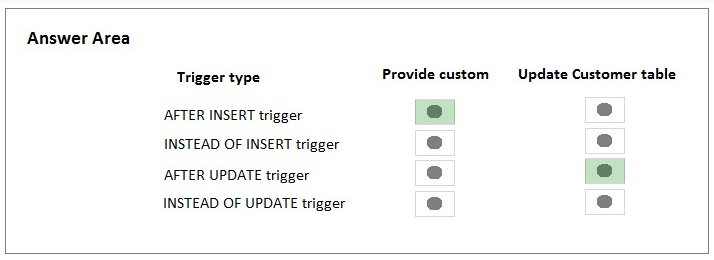
INSTEAD OF INSERT triggers can be defined on a view or table to replace the standard action of the INSERT statement.
AFTER specifies that the DML trigger is fired only when all operations specified in the triggering SQL statement have executed successfully.
Reference:-https://technet.microsoft.com/en-us/library/ms175089(v=sql.105).aspx
|
|
Question No:-4
|
HOTSPOT -
Note: This question is part of a series of questions that use the same scenario. For your convenience, the scenario is repeated in each question. Each question presents a different goal and answer choices, but the text of the scenario is exactly the same in each question in this series.
You have a database named Sales that contains the following database tables: Customer, Order, and Products. The Products table and the Order table are shown in the following diagram.
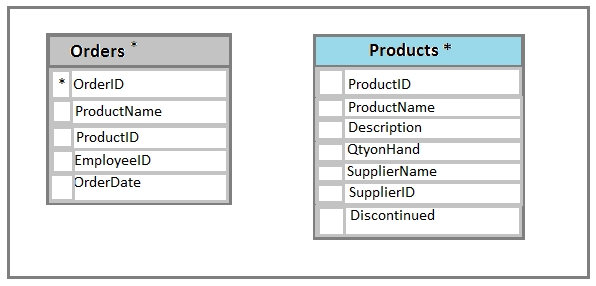
The customer table includes a column that stores the data for the last order that the customer placed.
You plan to create a table named Leads. The Leads table is expected to contain approximately 20,000 records. Storage requirements for the Leads table must be minimized.
The Leads table must include the columns described in the following table.

The data types chosen must consume the least amount of storage possible.
You need to select the appropriate data types for the Leads table.
In the table below, identify the data type that must be used for each table column.
NOTE: Make only one selection in each column.
Hot Area:
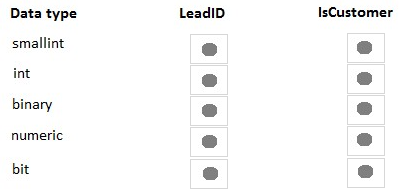
|
Question No:-5
|
HOTSPOT -
Note: This question is part of a series of questions that use the same scenario. For your convenience, the scenario is repeated in each question. Each question presents a different goal and answer choices, but the text of the scenario is exactly the same in each question in this series.
You have a database named Sales that contains the following database tables: Customer, Order, and Products. The Products table and the Order table are shown in the following diagram.
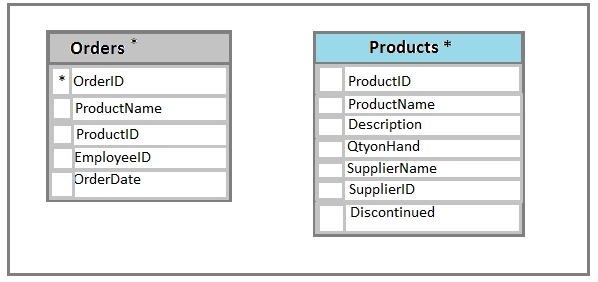
The customer table includes a column that stores the data for the last order that the customer placed.
You plan to create a table named Leads. The Leads table is expected to contain approximately 20,000 records. Storage requirements for the Leads table must be minimized.
You need to modify the database design to meet the following requirements:
- Rows in the Orders table must always have a valid value for the ProductID column.
- Rows in the Products table must not be deleted if they arepart of any rows in the Orders table.
- All rows in both tables must be unique.
In the table below, identify the constraint that must be configured for each table.
NOTE: Make only one selection in each column.
Hot Area:

Answer:- Note:-
Note:-
A FOREIGN KEY in one table points to a PRIMARY KEY in another table. Here the foreign key constraint is put on the ProductID in the Orders, and points to the ProductID of the Products table.
With a check constraint on the ProductID we can ensure that the Products table contains only unique rows.
Reference:-http://www.w3schools.com/sql/sql_foreignkey.asp
|
|
|